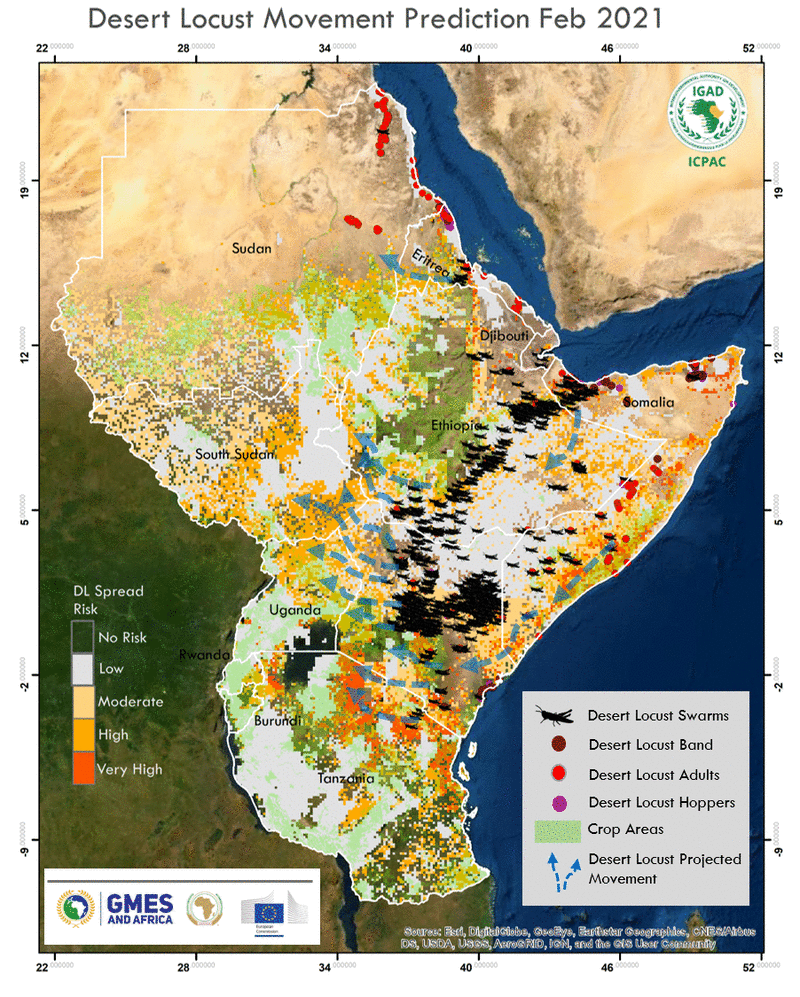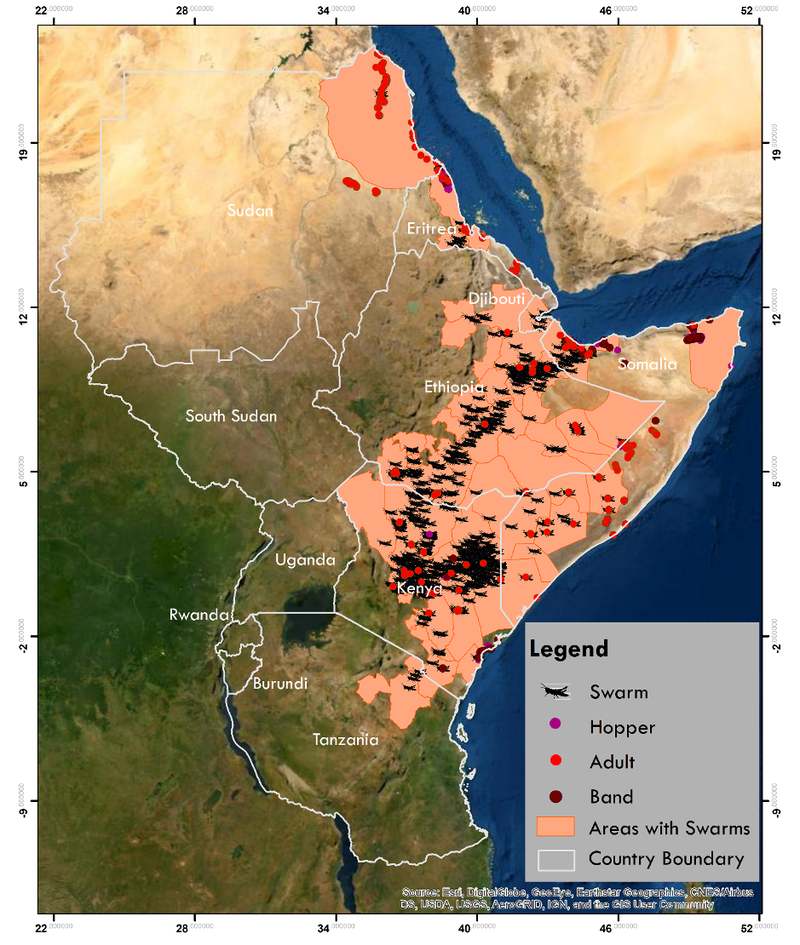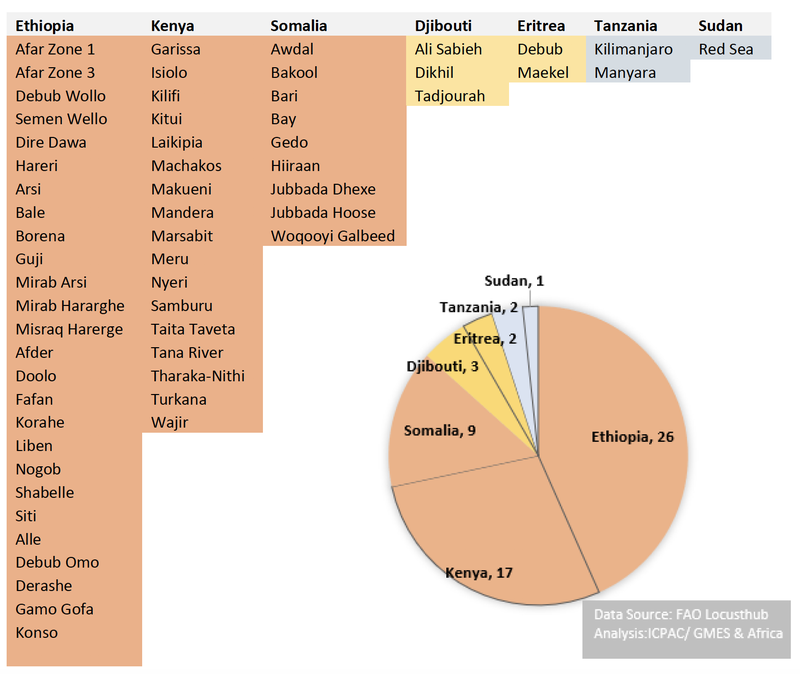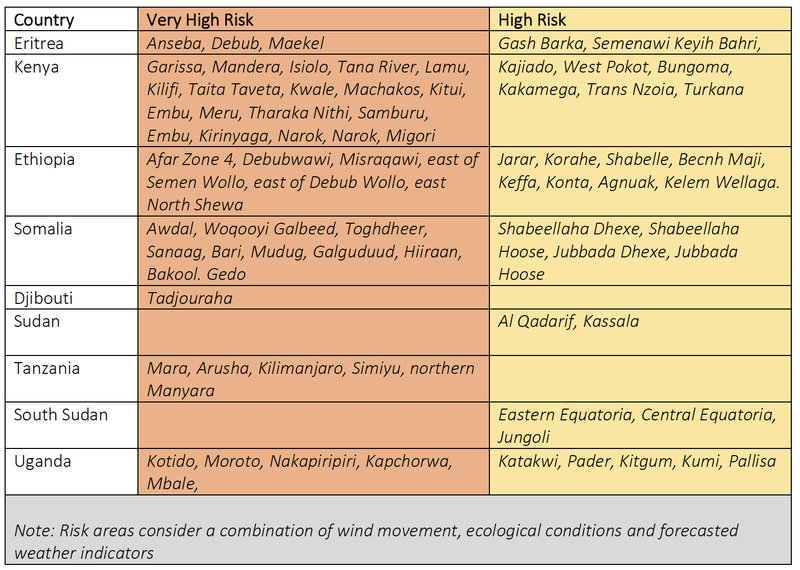Very High Risk of Impacts to Crops and Rangelands
Very high risk of significant impact to both crops and rangelands in Ethiopia, Somalia, and Kenya due to the high numbers of swarms

Projected impact on food and fodder
- Very high risk of significant impact to both crops and rangelands in Ethiopia, Somalia, and Kenya due to the high numbers of swarms recorded which are likely to breed in time for the new crop season. In Kenya, some central, eastern, and northeastern areas are currently in the short crop season.
- There is a risk of swarms within Somalia to invade more crop and grazing areas in the northern part of the country due to wind movement and the search for suitable breeding areas.
- Ethiopia’s crops for the Belg season which starts in mid-February are at high risk due to the high number of swarms which may lead to egg laying and higher locust numbers during the crop. The young crops are at high risk.
- Vegetation conditions are lesser suitable to sustain big swarms due to drier conditions before the March-May rainfall. This has the potential of increasing locust numbers due to surplus vegetation made available.
Areas with desert locust swarms

Desert Locust Spread
- Currently, the highest number of swarms have been reported in northern and central Ethiopia in a total number of 26 Zones, north-eastern, eastern, and coastal regions of Kenya in 17 counties and 9 regions of Somalia. These are the most affected areas.
- At this stage, hoppers have been reported in few locations showing low reproduction in the recent days, this may change with the start of the expected rainfall season first in the northern parts of Eastern Africa, at end of February, and in central regions in mid to end of March.
Locations with Reported Swarms Jan-Feb 10th, 2021

Forecasted climatic and ecological conditions
- Conditions that favor swarms to migrate in search of areas to lay eggs and moist sandy soils are taking place in fewer areas of Eastern Africa.
- Climatic conditions suitable for desert locust development are forecast to be highly suitable in north-eastern, eastern, coastal, and south-western Kenya, northern Tanzania, northern, central, and southern Somalia, and coastal areas of Eritrea.
- Ecological conditions (particularly the availability of green vegetation) continue to be suitable in the northern parts of the region due to the current higher than usual rains received in the October-December season which continues to sustain vegetation growth. This is a likely driver as to why the locust invasion continues to be in high intensity in Ethiopia Rift Valley.
- Wind direction and speeds, which greatly determine swarm movement, are forecasted to be northeasterly in Somalia likely to favor southward and westward locust movement for the mature swarms. Northern Ethiopia and Eritrea have a wind direction forecasted to favor northwest locust swarm movement towards borders with Sudan.
- Hoppers and hopper bands that indicate recent breeding and locust development have been reported in:
- The Red Sea and River Nile of Sudan
- Debub and Deubawi of Eritrea
- Awdal, Woqooyi Galbeed, Bari, Mudug, Hiraan, Shabeellaha Hoose, Bay, Gedo, and Jubbada Hoose in Somalia
- Doolo and Borena Ethiopia
- Isiolo, Kilifi, Lamu and Taita Taveta Counties of Kenya
Desert locusts are projected to move from:
- Galguduud and Mugud to Hiiraan, Shabeelle, Jubba and Bay regions of Somalia
- Ethiopia Doolo, Korahe, Shabelle and Jarar to Nogob, Afder and eastern Bale.
- Deubawi, Mehakeleghaw and Misraqawi Ethiopia to Gash Barka Semenawi Keih Bahri parts of Eritrea
- Intermittent multi-directional winds may favour swarms to move in varying directions during the projection period.
Highest risk areas
Highest risk areas for Desert Locust swarms and adult locust invasion based on forecasted climate conditions and existing vegetation suitable for an invasion are outlined below:

REFERENCES
Data on locust locations obtained from FAO Locust Hub, downloaded 10 Feb 2020. Forecast Data, ICPAC February 2021 1-month and 11-28 February forecast.
